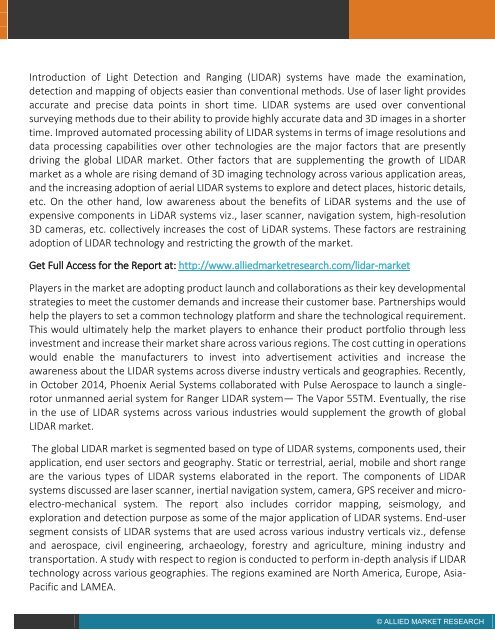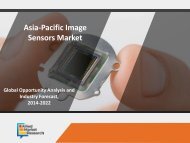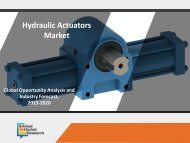Global LIDAR Market (Product type, Applications, Component, ENd-User and Geography) - Size, Share, Global Trends, Company Profiles, Demand, Insights, Segmentation and Forecast, 2013 - 2020
Introduction of Light Detection and Ranging (LIDAR) systems have made the examination, detection and mapping of objects easier than conventional methods. Use of laser light provides accurate and precise data points in short time. LIDAR systems are used over conventional surveying methods due to their ability to provide highly accurate data and 3D images in a shorter time.
Introduction of Light Detection and Ranging (LIDAR) systems have made the examination, detection and mapping of objects easier than conventional methods. Use of laser light provides accurate and precise data points in short time. LIDAR systems are used over conventional surveying methods due to their ability to provide highly accurate data and 3D images in a shorter time.
You also want an ePaper? Increase the reach of your titles
YUMPU automatically turns print PDFs into web optimized ePapers that Google loves.
Introduction of Light Detection <strong>and</strong> Ranging (<strong>LIDAR</strong>) systems have made the examination,<br />
detection <strong>and</strong> mapping of objects easier than conventional methods. Use of laser light provides<br />
accurate <strong>and</strong> precise data points in short time. <strong>LIDAR</strong> systems are used over conventional<br />
surveying methods due to their ability to provide highly accurate data <strong>and</strong> 3D images in a shorter<br />
time. Improved automated processing ability of <strong>LIDAR</strong> systems in terms of image resolutions <strong>and</strong><br />
data processing capabilities over other technologies are the major factors that are presently<br />
driving the global <strong>LIDAR</strong> market. Other factors that are supplementing the growth of <strong>LIDAR</strong><br />
market as a whole are rising dem<strong>and</strong> of 3D imaging technology across various application areas,<br />
<strong>and</strong> the increasing adoption of aerial <strong>LIDAR</strong> systems to explore <strong>and</strong> detect places, historic details,<br />
etc. On the other h<strong>and</strong>, low awareness about the benefits of LiDAR systems <strong>and</strong> the use of<br />
expensive components in LiDAR systems viz., laser scanner, navigation system, high-resolution<br />
3D cameras, etc. collectively increases the cost of LiDAR systems. These factors are restraining<br />
adoption of <strong>LIDAR</strong> technology <strong>and</strong> restricting the growth of the market.<br />
Get Full Access for the Report at: http://www.alliedmarketresearch.com/lidar-market<br />
Players in the market are adopting product launch <strong>and</strong> collaborations as their key developmental<br />
strategies to meet the customer dem<strong>and</strong>s <strong>and</strong> increase their customer base. Partnerships would<br />
help the players to set a common technology platform <strong>and</strong> share the technological requirement.<br />
This would ultimately help the market players to enhance their product portfolio through less<br />
investment <strong>and</strong> increase their market share across various regions. The cost cutting in operations<br />
would enable the manufacturers to invest into advertisement activities <strong>and</strong> increase the<br />
awareness about the <strong>LIDAR</strong> systems across diverse industry verticals <strong>and</strong> geographies. Recently,<br />
in October 2014, Phoenix Aerial Systems collaborated with Pulse Aerospace to launch a singlerotor<br />
unmanned aerial system for Ranger <strong>LIDAR</strong> system— The Vapor 55TM. Eventually, the rise<br />
in the use of <strong>LIDAR</strong> systems across various industries would supplement the growth of global<br />
<strong>LIDAR</strong> market.<br />
The global <strong>LIDAR</strong> market is segmented based on <strong>type</strong> of <strong>LIDAR</strong> systems, components used, their<br />
application, end user sectors <strong>and</strong> geography. Static or terrestrial, aerial, mobile <strong>and</strong> short range<br />
are the various <strong>type</strong>s of <strong>LIDAR</strong> systems elaborated in the report. The components of <strong>LIDAR</strong><br />
systems discussed are laser scanner, inertial navigation system, camera, GPS receiver <strong>and</strong> microelectro-mechanical<br />
system. The report also includes corridor mapping, seismology, <strong>and</strong><br />
exploration <strong>and</strong> detection purpose as some of the major application of <strong>LIDAR</strong> systems. End-user<br />
segment consists of <strong>LIDAR</strong> systems that are used across various industry verticals viz., defense<br />
<strong>and</strong> aerospace, civil engineering, archaeology, forestry <strong>and</strong> agriculture, mining industry <strong>and</strong><br />
transportation. A study with respect to region is conducted to perform in-depth analysis if <strong>LIDAR</strong><br />
technology across various geographies. The regions examined are North America, Europe, Asia-<br />
Pacific <strong>and</strong> LAMEA.<br />
© ALLIED MARKET RESEARCH
















